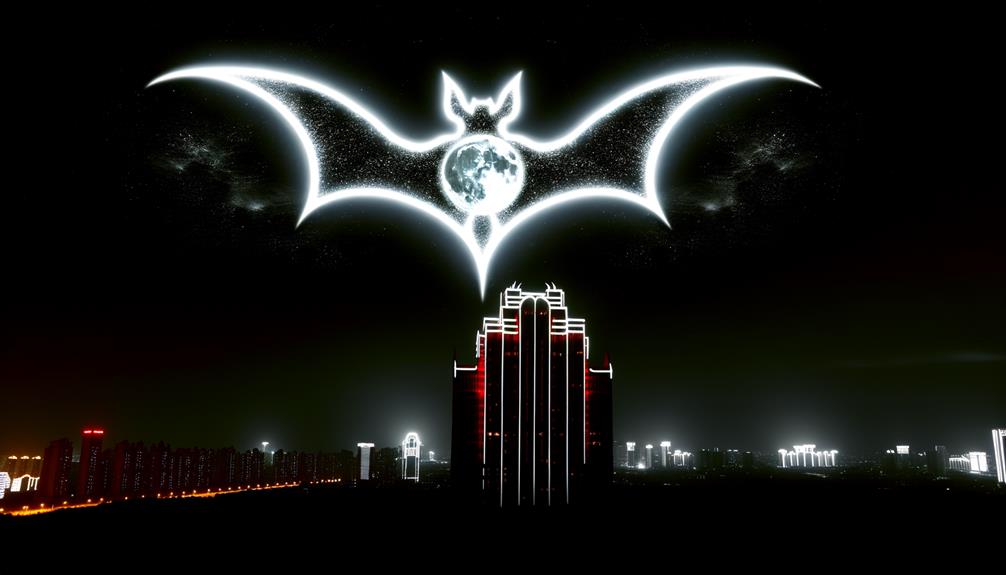What Does the Bat Symbol Mean for Gotham’s Sky?
The Bat-Signal, a beacon projected into the night sky, is an iconic symbol within the Batman franchise. Conceived by Commissioner James Gordon, it serves as both a strategic tool to summon Batman and a beacon of hope for Gotham City's citizens.
Its presence has adapted over the decades, reflecting the gritty realism, fantastical elements, and high-tech modern augmentations of different comic book eras. In addition to deterring crime, it symbolizes the alliance between Batman and law enforcement while reinforcing Batman's complex identity.
Famous worldwide, the Bat-Signal's cultural impact extends far beyond the comics, embodying themes of vigilance and protection. Discover its evolving journey and lasting legacy.

Key Takeaways
- The Bat-Signal is a strategic tool created by Commissioner Gordon to summon Batman.
- It serves as a beacon of hope and a psychological deterrent for Gotham's criminals.
- The Bat-Signal symbolizes the alliance between Batman and Gotham's law enforcers.
- Modern depictions use high-definition graphics and CGI for enhanced impact in films and games.
- The Bat-Signal is a globally recognized icon with significant cultural and symbolic meaning.
Origins of the Bat-Signal
How did the iconic Bat-Signal, a symbol of hope and vigilance, originate within the lore of Gotham City?
Conceived by Gotham City Police Commissioner James Gordon, the Bat-Signal emerged as a strategic tool to summon Batman in times of dire need. In a city plagued by rampant crime and corruption, traditional law enforcement methods often proved inadequate.
The Bat-Signal, projected from the rooftop of the Gotham City Police Department, became a beacon of hope for citizens and a deterrent for criminals. Its psychological impact was profound; the fear it instilled in Gotham's underworld was as significant as the reassurance it provided to its law-abiding inhabitants.
Consequently, the Bat-Signal symbolized an unorthodox but necessary alliance between Batman and the city's law enforcers.
Evolution in Comics
The Bat-Signal's depiction has undergone significant transformations in the comics, reflecting broader shifts in artistic styles and narrative themes over the decades.
Initially, its design mirrored the gritty realism of early Batman stories, emphasizing stark contrasts and shadowy outlines.
As the character evolved, so did the Bat-Signal, embodying the more fantastical and dynamic elements of the Silver Age with brighter, more stylized presentations.
The Dark Age of Comics saw a return to a more menacing and utilitarian design, symbolizing the period's darker, more complex narratives.
In modern iterations, the Bat-Signal often features high-tech augmentations, aligning with contemporary themes of technological advancement.
Each change in the Bat-Signal's design serves as a visual reflection of the era's prevailing artistic and thematic sensibilities.
Symbolism and Meaning

Throughout its history, the Bat-Signal has served as a powerful emblem of hope, authority, and vigilance within Gotham City, encapsulating the essence of Batman's role as its guardian.
This iconic symbol, projected against the darkened sky, functions as a dual-signifier: it is both a distress call and a deterrent. For citizens, it instills a sense of protection, an assurance that Batman is ever-watchful. Conversely, for criminals, it is a warning, a harbinger of impending justice.
The Bat-Signal's placement on Gotham Police's rooftop underscores its institutional endorsement, blurring lines between vigilante justice and state authority.
This intricate interplay of symbolism reinforces Batman's complex identity, balancing fear with hope, and individual action with communal responsibility.
Cultural Impact
In examining the cultural impact of the Bat-Signal, one must consider its transcendent status as a symbol that has permeated various forms of media, influencing not just comic book lore but also broader popular culture and societal perceptions of justice and heroism. Its evocative imagery has inspired countless adaptations in television, film, and literature, making it a globally recognized icon. The Bat-Signal's role in modern media underscores its enduring legacy and its ability to evoke themes of vigilance and protection.
| Medium | Influence | Example |
|---|---|---|
| Comic Books | Origin and evolution of concept | Detective Comics |
| Television | Adaptations and reinterpretations | Batman: The Animated Series |
| Film | Iconic visual representation | The Dark Knight Trilogy |
| Literature | Symbolic references | Various novels |
| Public Displays | Cultural and social events | Projections at events |
Technological Depictions

Advancements in technology have allowed for increasingly sophisticated and realistic portrayals of the Bat-Signal, enhancing its impact and authenticity in various media forms. High-definition graphics, computer-generated imagery (CGI), and advanced lighting techniques have evolved the Bat-Signal from a simple spotlight to an iconic, mesmerizing emblem.
In films, innovative digital effects enable dynamic scenes where the Bat-Signal interacts seamlessly with the environment, creating a more immersive experience. Video games utilize real-time rendering to produce high-fidelity representations, ensuring the Bat-Signal retains its symbolic power. Animated series leverage sophisticated software to animate the Bat-Signal with greater fluidity and detail.
These technological strides have cemented the Bat-Signal as a visually compelling and enduring symbol in contemporary storytelling.
Real-World Inspirations
The bat symbol, as a prominent icon in modern culture, draws from both historical symbolism and contemporary influences. Its origins can be traced to ancient mythologies where bats often represented mystery and transformation.
Modern interpretations are heavily shaped by the character of Batman in comic books and films. This intersection of historical and pop cultural elements underscores the symbol's enduring appeal and multifaceted significance.
Historical Symbolism Origins
Historical symbolism surrounding the bat symbol finds its origins in various mythologies and cultural narratives that have depicted bats as creatures of mystery and transformation.
In ancient Chinese culture, bats were considered symbols of happiness and good fortune, often depicted in art to convey blessings.
Conversely, in Western folklore, bats have frequently been associated with darkness and the supernatural, linked to notions of the underworld and witchcraft.
Indigenous tribes in the Americas viewed bats as symbols of rebirth and intuition due to their nocturnal nature and unique navigational abilities.
These varying interpretations illustrate the bat's complex role in human culture, embodying both positive and negative connotations, thereby enriching its symbolic significance across different historical contexts.
Modern Pop Culture Influences
Drawing from historical symbolism, modern pop culture has reinterpreted the bat symbol through the lens of contemporary narratives, greatly influenced by the creation of iconic characters and stories such as Batman. Introduced by DC Comics in 1939, Batman's emblem has transcended its fictional origins to become a prominent cultural icon.
This transformation is rooted in the character's embodiment of dualities—fear and hope, darkness and justice. The bat symbol, often depicted as a signal in the night sky, serves as a beacon of vigilance and resilience. Its adoption in various media—films, television, and merchandise—highlights its pervasive influence.
Moreover, its real-world inspirations draw from mythological and psychological archetypes, cementing its legacy as a symbol of protection and mystery in modern culture.
Future of the Bat-Signal
As Gotham City advances technologically, the Bat-Signal's role and design must adapt to maintain its efficacy and symbolism in an evolving landscape. The traditional spotlight, while iconic, may soon be complemented by digital advancements.
Holographic projections and encrypted digital signals could offer more discreet, yet equally powerful, methods for summoning Batman. Additionally, integrating the Bat-Signal into Gotham's smart city infrastructure could enhance real-time responsiveness and situational awareness.
However, such evolutions must balance modernity with the cultural and psychological impact of the original symbol. The Bat-Signal's enduring presence serves not just as a call to action but as a beacon of hope, necessitating innovations that preserve its essence while embracing new technological frontiers.
Conclusion
The Bat-Signal, evolving from its comic book origins to a symbol of hope and justice, demonstrates profound cultural and technological significance.
For instance, a notable real-world application occurred in Los Angeles, where the Bat-Signal was projected onto City Hall following actor Adam West's passing, illustrating its enduring influence.
This case underscores the Bat-Signal's potent symbolism, transcending fiction and becoming a beacon of communal solidarity and tribute.
Its future likely holds continued evolution in both media and real-world expressions.






